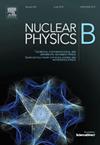Cosmological model in Finsler-Kropina geometrical framework with weak-field anisotropy and observational data
IF 2.5
3区 物理与天体物理
Q2 PHYSICS, PARTICLES & FIELDS
引用次数: 0
Abstract
This study explores the role of Finsler geometry in cosmology incorporating weak-field anisotropy through the Finsler-Kropina framework and the osculating Riemannian metric approach. The model naturally modifies the spacetime structure introducing anisotropic effects that influence cosmic expansion and energy conservation. By deriving the modified Friedmann equations we test their observational viability using observational datasets including cosmic chronometers, baryon acoustic oscillations and the Pantheon+ supernovae dataset. The results from MCMC analysis show deviations from the ΛCDM model particularly in the evolution of the Hubble parameter, matter density, and dark energy density. Compared to ΛCDM, the anisotropic model predicts a lower matter density parameter a reduced dark energy density , and a nonzero spatial curvature indicating fundamental geometric differences. The deceleration parameter confirms an accelerated expansion with a transition redshift , aligning with observational estimates. The state-finder diagnostics reveal a transition from a Chaplygin gas-like phase to a quintessence regime before asymptotically approaching ΛCDM demonstrating a dynamic evolution influenced by anisotropic corrections. The diagnostic suggests phantom-like behavior at higher redshifts gradually stabilizing towards ΛCDM at late times. We show that the geometry-induced effective dark energy term can be interpreted as a geometric component of dark energy, effectively driving late-time acceleration without invoking additional exotic matter fields. These findings highlight the significance of Finsler geometry in extending standard cosmology and suggest that anisotropic effects provide a geometric interpretation of dark energy while maintaining consistency with observational constraints.

具有弱场各向异性和观测数据的Finsler-Kropina几何框架中的宇宙学模型
本研究通过芬斯勒-克罗皮纳框架和密切黎曼度量方法探讨了芬斯勒几何在宇宙学中结合弱场各向异性的作用。该模型自然地修正了时空结构,引入了影响宇宙膨胀和能量守恒的各向异性效应。通过推导修正的弗里德曼方程,我们使用观测数据集(包括宇宙天文钟、重子声学振荡和万神殿+超新星数据集)来测试它们的观测可行性。MCMC分析的结果显示出与ΛCDM模型的偏差,特别是在哈勃参数、物质密度和暗能量密度的演化方面。与ΛCDM相比,各向异性模型预测了更低的物质密度参数Ωm0、更低的暗能量密度ΩΛ和非零空间曲率ΩK,这表明了基本的几何差异。减速参数q(0)=−0.57±0.001证实了加速膨胀,跃迁红移ztr≈0.77,与观测值一致。状态发现者诊断揭示了在渐近接近ΛCDM之前从Chaplygin类气相到精粹状态的转变,证明了受各向异性修正影响的动态演化。Om(z)诊断表明,在较高的红移处,幽灵般的行为在后期逐渐稳定到ΛCDM。我们表明,几何诱导的有效暗能量项Ωξ可以被解释为暗能量的几何成分,有效地驱动后期加速,而不调用额外的外来物质场。这些发现突出了芬斯勒几何在扩展标准宇宙学方面的重要性,并表明各向异性效应提供了暗能量的几何解释,同时保持了与观测约束的一致性。
本文章由计算机程序翻译,如有差异,请以英文原文为准。
求助全文
约1分钟内获得全文
求助全文
来源期刊

Nuclear Physics B
物理-物理:粒子与场物理
CiteScore
5.50
自引率
7.10%
发文量
302
审稿时长
1 months
期刊介绍:
Nuclear Physics B focuses on the domain of high energy physics, quantum field theory, statistical systems, and mathematical physics, and includes four main sections: high energy physics - phenomenology, high energy physics - theory, high energy physics - experiment, and quantum field theory, statistical systems, and mathematical physics. The emphasis is on original research papers (Frontiers Articles or Full Length Articles), but Review Articles are also welcome.
 求助内容:
求助内容: 应助结果提醒方式:
应助结果提醒方式:


